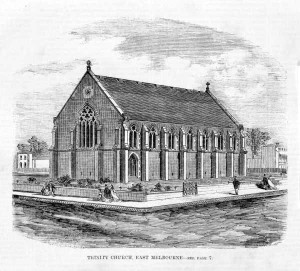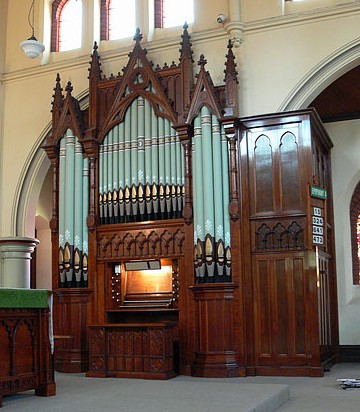About us
Our vision
Holy Trinity is a dynamic Christian community with a valuable history that reflects the inclusive hospitality of God to all peoples and experiences. We are committed to make the love of Christ known, and to serve the community in His name.
Our story
 Anglican worship started in the Church of England schoolhouse on the corner of Victoria Parade and Hoddle Street in 1857 – serving as a mission church to the working class families on the low-lying Richmond and Collingwood flats.
Anglican worship started in the Church of England schoolhouse on the corner of Victoria Parade and Hoddle Street in 1857 – serving as a mission church to the working class families on the low-lying Richmond and Collingwood flats.
In 1864 a bluestone church was built on the George Street corner of the present site – a place designated as the site for the Cathedral. That church was destroyed by fire in 1905 and the present church was built at the opposite end of the block and consecrated in October 1907.
In 1970 the former Vicarage on Clarendon Street was sold and the present house was purchased. From 2004 the parish hall was the temporary home for the East Melbourne Library whilst its new building was being constructed on George Street.
Our music
This organ is the third of three organs used by the congregation of Holy Trinity. The first organ in the newly-built 1864 Holy Trinity building sited on the cnr of George and Clarendon Sts was an 1854 Smith & Co Bristol previously installed in the Mechanics Institute Hall (Athenaeum Hall) Collins St. Following a devastating fire on the 1st January 1905 both church and organ were destroyed. Rebuilding commenced on the cnr of Hotham and Clarendon Sts and on 5th January 1906 an order from Holy Trinity for a hire organ was received by Geo. Fincham. This instrument remained in use until May 1913 when the present instrument was installed by William Anderson.
The present organ was purchased from the estate of Mr Henry M Boom of ‘Yarradale’ Fordholm Rd. Hawthorn. According to a newspaper advertisement the house contained a ‘Magnificent Drawing-room or Music-room, with Handsome Wooden Gothic Ceiling’. It incorporates an outstanding case in fiddleback blackwood, almost certainly by Alfred Fuller.
It is a rare example of an instrument constructed by an amateur organ builder for domestic use in the late 19th Century. It appears probable that Boom built most of the organ with the assistance of organ builders Alfred Fuller and Fred Taylor who both lived and had workshops in close proximity. Furthermore Booms’s house was equipped with a large workshop.
Boom made most of the wooden pipework many of which are fronted in costly mahogany. One builder noted “that the wood pipes present a magnificent example of the art of organ building. They are magnificently made and voiced. It is very rare to see such small pipes, which extend to within the last octave of the top of the 2ft rank. The work of Henry boom can only be greatly admired” As far back as June 1872 Boom imported from J.W. Walker in London assorted pipework of ‘fine spotted metal’ at a cost of 50 pounds. Nevertheless there is evidence of some pipework predating this time.
The organ remained in its original state until 1971 when it went under some reconfiguration. The swell box was removed as was the swell clarionet which was replaced with a 2 rank mixture.
The instrument’s historic significance was recognised in August 2010 when it received a National Trust classification of Regional Significance.
A restoration fund has been established to return the instrument to its original condition and specifications. The fund will also attend to the mechanical and coupler actions, both in need of restoration. The bellows are also in need of releathering, and the many leaks in the windchests repaired. If you would like to contribute to the fund please complete this Organ Donation form and submit to The Melbourne Anglican Cultural Organisation.
Our partnerships
We belong to the worldwide fellowship of churches of the Anglican Communion under the leadership of the Archbishop of Canterbury, Justin Welby; the Anglican Church of Australia whose Primate is Archbishop Geoffrey Smith; the Diocese of Melbourne, whose Archbishop is Philip Freier.
We also hold membership of the ecumenical Melbourne City Churches in Action.
Our church
To see our community in action, visit our gallery.
